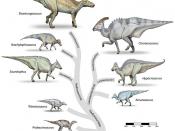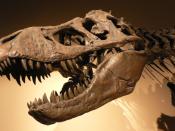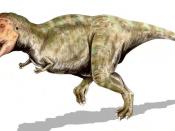Paleontologists
Paleontology is the hardest field of any kind of scientific studies.
There are many reasons, one is not only do they dig up bones, but they also collect teeth,
claws, skin, hair, fish scales, eggshells, tracks, insects, leaves, dinosaur nests, and even
microscopic pollen. They also don't just find and collect different specimens, they also
study the fossils, the rocks the fossils are buried in, the rocks they also lie above, below,
and near the fossils. They study these today by using highly sophisticated tools. They
study these things to find out how they lived in herds, alone or, in pairs. Paleontologists
also have to study astronomy to learn about if there were any great catastrophes by
meteors causing giant craters which might have created mass extinctions, or caused life to
evolve in new directions. By studying the bones of a dinosaur was sick, injured, or how it
died.
One thing paleontologists studied, and argued about was if
dinosaurs were warm blooded or cold blooded. Most scientists believe that dinosaurs
were warm blooded.
Today, Paleontologists study or closely related species to try to
have an idea of how the dinosaur in question behaved.
Also they never know when they will find a new type of dinosaur.
Carnivores
Carnivorous dinosaurs strictly ate meat. Carnivores were fast, had
large jaws, and back curved teeth. The most famous carnivore was the Tyrannosaurus
Rex, which means "Lizard king." Although we now know that the Tyrannosaurus Rex
was not the biggest, smartest, or even that fastest. There were much more dangerous
carnivores. One example would be the Spinosauraus, a much bigger creature. It had a
longer snout, or sail, and stood much higher.
Carnivore fossils are quite rare compared to that if herbivores.
Carnivores ate herbivores which meant plant eaters. The carnivores all
had the same basic structure, claws, sharp teeth, and bird hips. They were either
scavengers, or hunters. The majority of carnivores lived alone, but raptors hunted in
packs.
Veociraptors were the smartest of all dinosaurs. They hunted in park,
and even had socialization, meaning they talked to each other. If they had not gone
extinct they would have definitely became the dominant species with their razor sharp teeth and 6 inch claws. They would have the human species as prey.
Herbivores
The most famous type of herbivore was the long necks, also known as
the Saurapods. They were giants with long necks, long tails, short stumpy legs, and small
heads. They were still feared by even the most powerful carnivores. The largest of these
was the Argentinasaurus, recently discovered, little known about it but, it was so big that
when it walked the Earth, actually shook near it. These gentle giants were harmly as far
as claws go but, for a defense, the Saurapods used their tails and weight to kill the
Carnivores that attacked. Like all herbivores, they constantly searched for food (leaves on
tall trees as their source of food) in herds with the offspring in the middles with the adults
around the offspring. Their structure is unmistakable with small heads, long necks,
long tails, and large body with short stumpy legs. The Sauarapods will always be
remembered as giants.
The dinosaurs known as the Triceratops were first found in 1887. The
first fossils were mistaken as an extinct type of buffalo because of the horns that went
over the eyes for protection. They also had a much smaller horn over the nose. Instead of
having a mouth, they had a beak. These herbivores also lived in herds and using their
beaks to break off small branches with their sharp beaks and ate the leaves and branches.
At about 10 ft. tall, these creatures looked extremely fierce.
Conclusion
The conclusion is that paleontology is very difficult. You must be
able to know many different things and know that new discoveries about an old
specimen may be found out at any time. The types of dinosaurs change to meet its
needs to live a particular way. Like humans, raptors were successful because of the way
they interacted with each other and hunted. Like cows, Sauropods lived alike as well,
constantly searching for food and serving as food for the more intelligent creatures.


